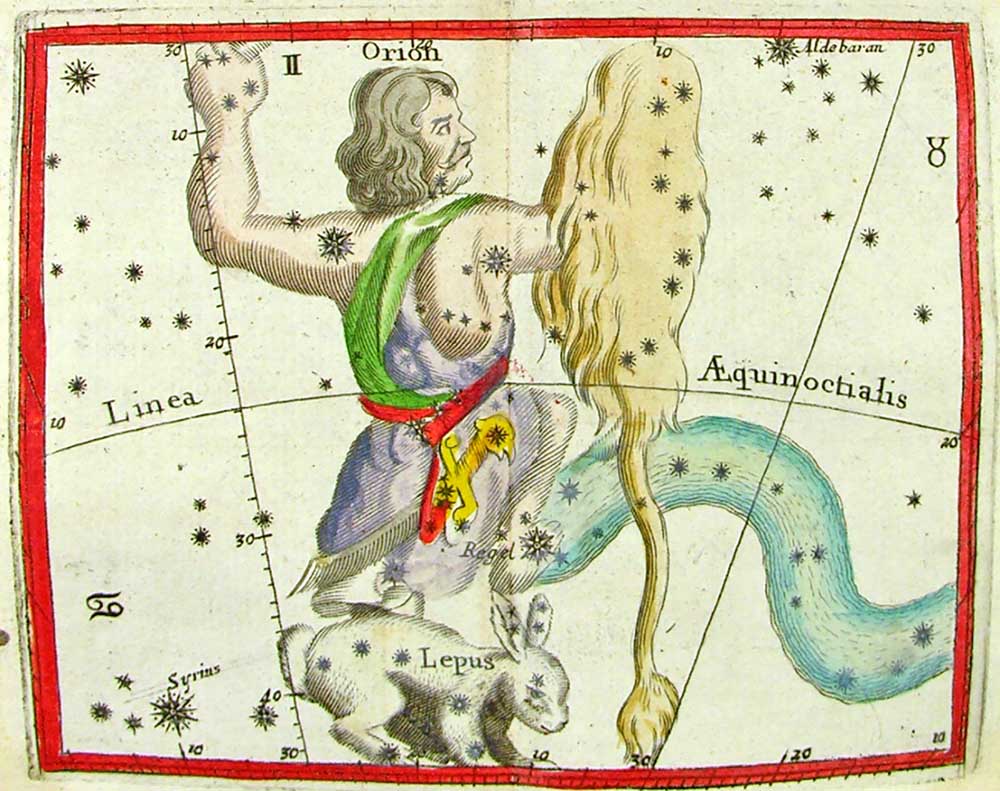Coast Chronicles: La nuit est belle — The night is beautiful!
Published 8:42 am Monday, September 30, 2019

- The constellation Orion presides over winter’s night sky and is easy to find with his distinctive three-star belt. “There is surely no finer way to begin a tour of the constellations than with the magnificent Orion. In the crisp, invigorating air of a winter night, direct your gaze high in the southern sky, and look for the three bright stars in a row that mark Orion’s belt. They are unmistakable, and will quickly catch your eye,” according to http://www.peoplesguidetothecosmos.com.
Saturday night/Sunday morning had a wintery chill to it. I was up early and the air was frosty — I wonder if I’ll need to start moving some plants inside or at least onto the porch? — and we’re barely finished with September! I suppose soon we’ll be looking at the Willapa Hills across the bay and see snow.
Last Monday we passed the September Equinox: the time when the sun crosses the celestial equator on its way south. Traditionally in the northern hemisphere it’s when autumn begins, and in the southern hemisphere spring. And we’ve also passed the harvest moon — mid-September — a time when the moon remains visible for a couple extra hours after sunset, which meant for agrarian folks extra hours of work during a busy picking season. (And what a harvest we’ve had this year! — a bumper crop of both apples, Asian pears, and — especially with our dry and warm summer days — a bounty of Peninsula tomatoes.)
But here we go — perhaps we’ve already turned the corner into winter. Soon my favorite constellation, Orion the Hunter, will be visible in the evening and tipping onto the horizon in the early morning hours. According to astronomer Bob Berman (his blog is “This Week’s Amazing Sky”) “One of Orion’s shoulders, orange Betelgeuse, is the largest bright star in all the heavens. If our earth were represented by the period at the end of this sentence, Betelgeuse would be a ball as tall as a 20-story building. One of Orion’s knees, Rigel, a blue supergiant star, is among the most luminous objects in the galaxy, shining with the light of 55,000 suns. If it were nearby, we could read by its light, and the night sky would be deep blue instead of black.”
Darkness
Often we’re not aware of the benefits we possess until we lose them, and darkness is one of those. Dark night skies are finally becoming more recognized as valuable, even as they disappear. Certainly one of our Peninsula gifts is darkness at night. (Another is how quiet it gets at night — something that so many urban dwellers remark about when they visit. Generally speaking we have no sirens, no traffic, and no gunshots to disturb us — only the rumbling ocean.) We’re lucky on the Peninsula that we can still see the stars. Many billions of people living in or near urban areas only have a foggy yellow glow at night and all night.
As a National Geographic site notes, “Thanks to our incessant obsession with artificial light, we have ruined the nighttime sky. More than 80 percent of the planet’s land areas — and 99% of the population of the United States and Europe — live under skies so blotted with man-made light that the Milky Way has become virtually invisible.” This is a loss of tremendous proportions, quite literally. The Milky Way — 100,000 light years across — is where we live; having a view of it puts us in our place, gives us a sense of the magnitude of our galaxy, and a small taste of the magic and miracle of our own existence.
Dark sky park?
Years ago I wrote in my column about the possibility of designating some portion of our Peninsula a “Dark Sky Park.” Our geographical position might make it possible — we’re quite far from major urban areas and our light pollution is minimal. There are currently 37 Dark Sky Parks in the U.S. and 53 in the world. (A complete listing here: https://tinyurl.com/y2fyvsbd and Dark Sky Park guidelines here: https://tinyurl.com/y44c6nvl). As darkness becomes a more precious commodity, Dark Sky Parks have growing tourist appeal as well.
But even if no legal certification were possible, we could still be more aware of our night skies and work on how to keep them. We’d all need to be more diligent about installing the kinds of light fixtures that direct light downward rather than skyward. (There are many sites that help to identify appropriate fixtures. More on this in the future.)
There are several membership groups that focus on the resource of “darkness:” The International Dark Sky Association ( IDA’s website here: https://www.darksky.org) and Dark Sky Society (http://www.darkskysociety.org). And there is another certification which requires a larger area and more rigorous application — Dark Sky Reserves. In January of 2018, IDA announced the accreditation of the Central Idaho Dark Sky Reserve, the 12th internationally and the first in the nation. (Today there are 13 in total. Here’s the complete list: https://tinyurl.com/y2ns64zk).
Darkness at night is something that we humans grew up with evolutionarily and have experienced for all of our cultural development, until recently (at least in geological time). We created mythology about our stunning night skies; we made star clusters into animals and totems; we navigated by the stars; and we used the stars to connect us more closely to the shifting seasons and the position of our earth in the heavens. Sadly, I have a brilliant 12-year-old friend who told me he has never seen the Milky Way; he didn’t even understand what it was. Losing this connection is another unfathomable break in our link to the environment.
La nuit est belleLa nuit est belle — The night is beautiful! — is a Swiss effort to recognize and mitigate the loss of darkness at night. It was spearheaded by Geneva and 150 municipalities in the surrounding area which agreed to turn off city lights in a specified area for one night, Sept. 26. (Electricity in homes and other critical areas was left on or turned off only voluntarily.) As curator of Geneva’s Museum of Natural History, Pascal Moeschler, said, “The initiative aims to raise awareness of the harmful effects of light pollution and also allow our one million inhabitants to see planets, stars, and the Milky Way again. After water pollution in the 1960s and air pollution in the 2000s, now is the time to become aware of light pollution’s effects.” (More info here: https://www.lanuitestbelle.org/programme/.)
As well as the loss of seeing the Milky Way, artificial lighting can negatively affect plants — delay leaf fall, degrade photosynthesis, disrupt sprouting, and prevent nocturnal pollination of plants by moths. It’s also been found to change the prey-predator ratio and disrupt bird and animal migration. As for us humans, studies have shown that artificial light at night is behind many sleep disorders, interrupts our 24-hour cycle of circadian rhythms, and is responsible for a drop in melatonin (the hormone responsible for triggering the onset of sleep).
These are all important, and mostly undiscusssed or under-valued, benefits of darkness. But for me, the most important aspect of darkness is aesthetic. In my 20-plus years as a Berkeley, CA. resident, I loved the hustle and bustle, the cultural variety and richness, the food (OMG!), the transportation convenience, the political acumen, the tech-everything… but… every night when I looked up at the sky, I saw a sickly sallow billow of glare.
I can’t tell you how many times I walk out onto my Nahcotta porch now, turn off the lights, and simply glory in the stars. I wouldn’t trade that for anything.









